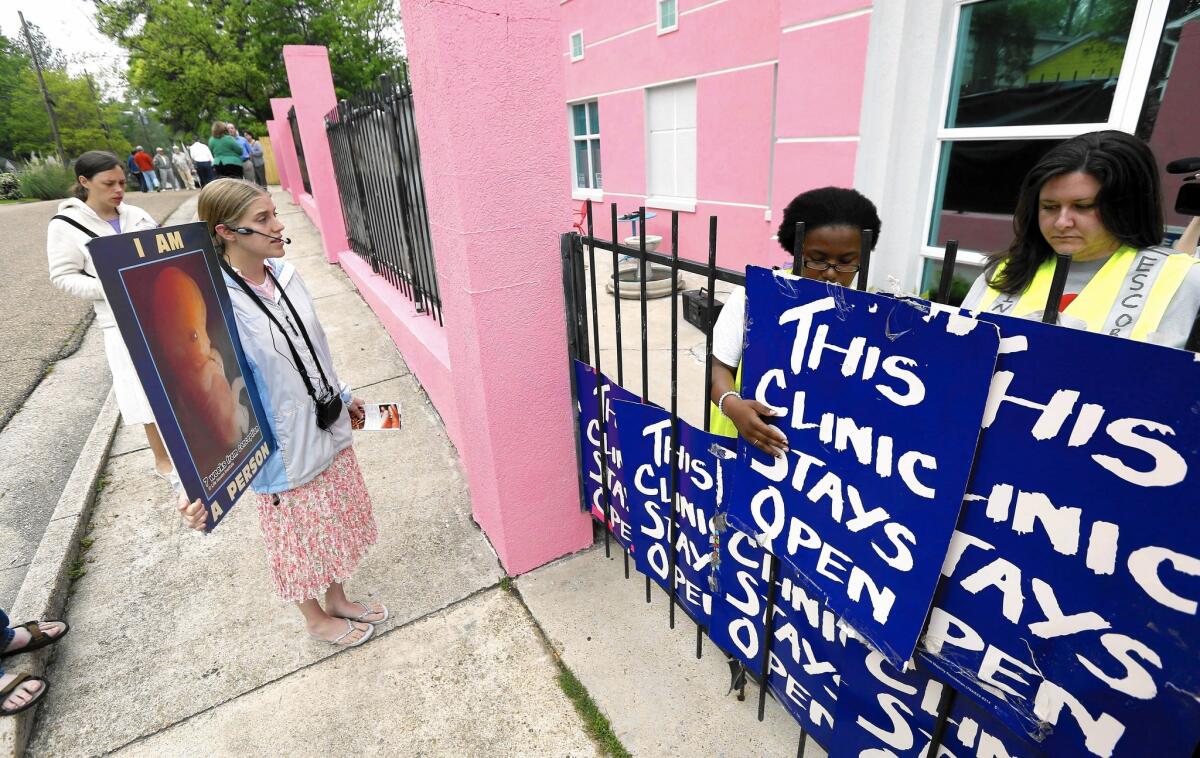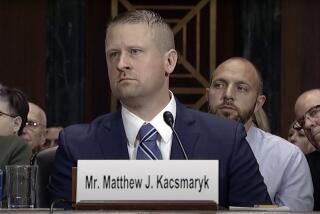Surge of new abortion restrictions limits access ‘brick by brick’

Abortion opponents demonstrate outside a clinic in Jackson, Miss., in 2013, while clinic employees secure signs to the front gate to help hide patients from protesters’ view.
- Share via
Reporting from SEATTLE — With state legislatures across the country passing dozens of abortion restrictions for the fifth year, access is becoming more limited than at any time since the Supreme Court’s landmark decision legalizing the procedure in 1973.
The current legislative session is shaping up to be among the most active, and abortion rights advocates point to what they call an alarming result of the steady flow of new laws: In some states, so many limitations have piled up that the procedure, while technically legal, is nearly impossible to obtain.
“It is a culmination of the wave of restrictions of the past three years,” said Nancy Northup, president of the Center for Reproductive Rights. “You see one type of restriction following another, following another. When you put them all together, the result is a closing-off of access.”
Jennifer Dalven, director of the ACLU’s Reproductive Freedom Project, describes it as “putting up a wall brick by brick by brick, slowly, so no one notices.” She points to Arkansas as among the states where the limitations have piled up — more than a dozen since 2011, about half of which were passed this year.
“If you look at each abortion restriction in isolation, you may think, it’s not great. It’s not what should be the law. But I’m not going to get worked up,” Dalven said. “But if you put it down on paper ... it becomes very clear what the state is trying to do — prevent a woman who’s decided to have an abortion from actually getting one.”
North Carolina and Oklahoma increased waiting periods to 72 hours. Kansas and Oklahoma banned dilation and evacuation, the most common surgical method of ending a pregnancy in the second trimester. Arkansas began requiring doctors to tell women that fetuses can feel pain and that anesthesia is available for the fetus during an abortion.
The backdrop for the latest burst of abortion restrictions is the Supreme Court, which is poised to announce as soon as Monday whether it will weigh in on the contentious issue in a major way for the first time since 1992. It is considering whether to hear two abortion-related cases, one from Mississippi, the other from North Carolina.
Carol Tobias, president of the National Right to Life Committee, credits “changing attitudes in the public” with the antiabortion movement’s successes in cutting access to the procedure.
“People are more willing to place limits on abortion,” said Tobias, whose organization has affiliates in all 50 states and works with legislators to craft bills. “The laws that are going through, most people think are reasonable and support them.”
The ultimate goal, she said, “is to protect all unborn children. But we are taking the steps that we can at this time to save as many babies as we can right now.... Legislation has been part of it.”
Laws that require women to wait between the initial consultation and the procedure have been a foundation of antiabortion efforts. The Guttmacher Institute, a reproductive rights research organization, counts 26 states with such measures.
Since April, five states have either instituted a waiting period or increased one. On Wednesday, Florida Gov. Rick Scott signed HB 633, putting in place a 24-hour delay for the first time. And North Carolina Gov. Pat McCrory signed HB 465 on June 5, tripling his state’s waiting period from one to three days. The other states are Tennessee, Oklahoma and Arkansas.
To Tobias, such delays are states’ way of saying “make sure she has good information and time to think about it. I don’t know of any other surgery where you go in, meet the doctor and have surgery the same day.”
But abortion rights advocates argue that such delays often require multiple clinic visits, increased travel costs and time off work, and can force women to have abortions later in their pregnancies and increase the risk.
“This is as if legislatures are saying, ‘Women really can’t make this decision, don’t know what is best for themselves and their families, and if we make them wait another day or two, they’ll see the light,’” said the ACLU’s Dalven. “It is another strategy to prevent women from getting the abortion that they have decided to have.”
This year, Arkansas has passed about half a dozen new restrictions on abortion, including measures that would require women seeking a medication abortion to make as many as four visits to a clinic.
Medication abortions are a two-step procedure. First, a healthcare provider gives the patient mifepristone while she is at a clinic. The drug blocks the hormone progesterone, causing the lining of the uterus to break down. Two days later, while at home, the patient takes a drug called misoprostol, which causes the uterus to empty.
Arkansas’ new laws include increasing the waiting period from 24 to 48 hours, requiring that pre-abortion counseling be done in person, making it harder for minors to obtain an abortion even with the consent of a parent, telling women that fetuses feel pain at 20 weeks, counseling them that medication abortions can be reversed, and requiring physicians who administer only medication abortions to have admitting privileges at a hospital.
Arkansas “is an example of a state that has changed access,” said Elizabeth Nash, a policy analyst at the Guttmacher Institute. “We’ve seen similar dramatic changes in places like Kansas, Texas, Arizona, Oklahoma and North Carolina. Those sorts of states have really changed how abortion is provided and obtained.”
In terms of access, “in some ways it looks like what we saw before” Roe vs. Wade, Nash said, referring to the 1973 decision that affirmed a woman’s right to the procedure. “What you’re seeing is access maintained for the most part along the West Coast and in the Northeast, but real incursions in access in the South and middle of the country.”
The restrictions, said Cecile Richards, president of the Planned Parenthood Action Fund, are “another cynical attempt to ban safe, legal abortion.... A woman’s right to make personal, medical decisions about abortion shouldn’t depend on where she lives.”
Twitter: @marialaganga
More to Read
Sign up for Essential California
The most important California stories and recommendations in your inbox every morning.
You may occasionally receive promotional content from the Los Angeles Times.











